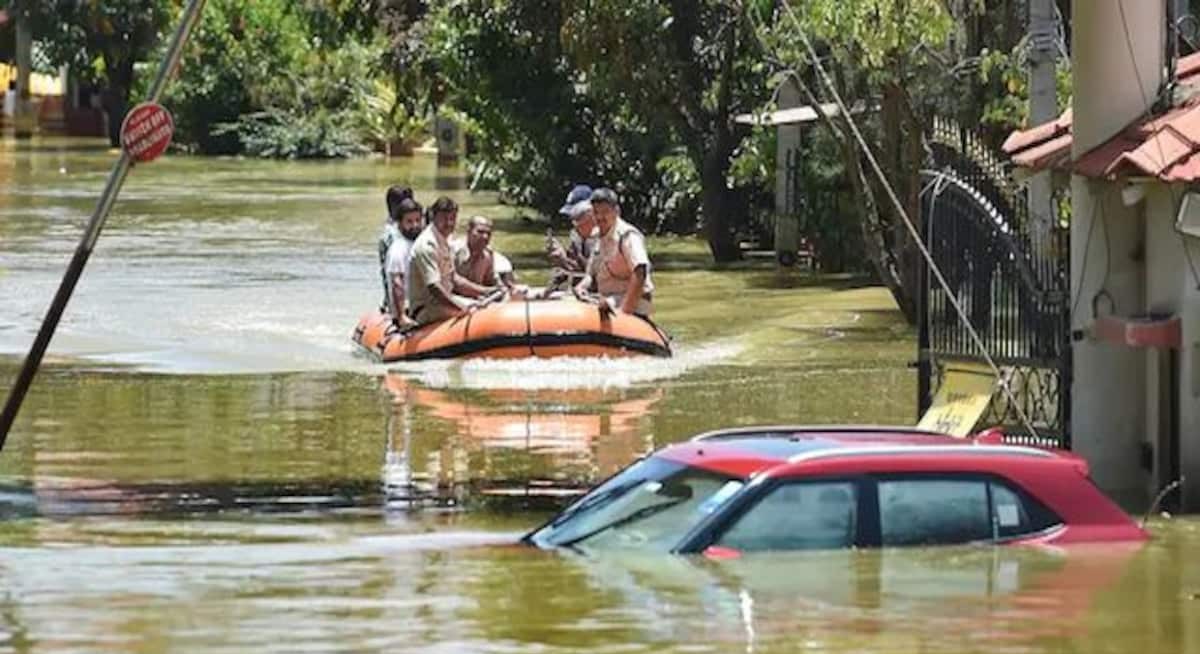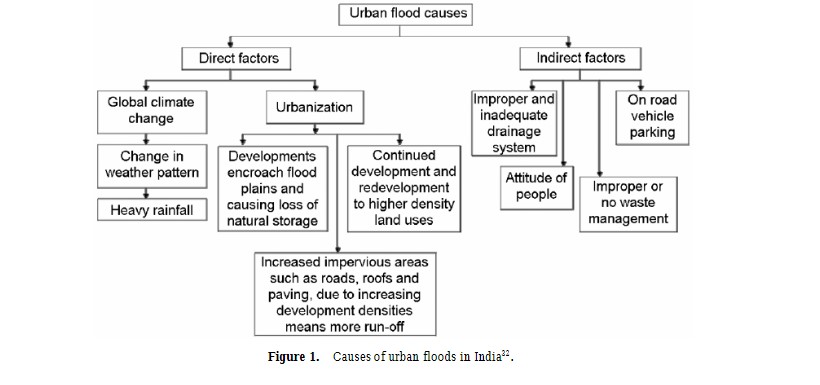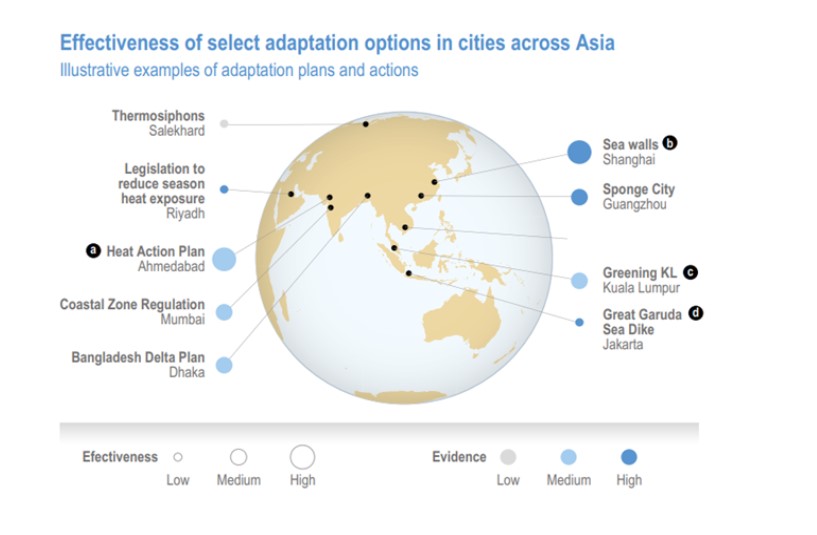What Bengaluru floods 2022 taught us about increasing threat of urban flooding in India
Bengaluru rains were a result of change in Monsoon trends that have of late become unpredictable and complex. However, meteorologists claim that extremely heavy rainfall cannot be blamed alone and that it was the city's bad urban planning that led to such a grave situation.
By Kartiki Negi / Sep 16, 2022

Image Credit: Firstpost
Climate change impacts continue to increase at an alarming rate with even more intensity and frequency. 2022 has so far recorded unprecedented floods in Bangladesh, followed by Assam floods, extremely heavy rains in Madhya Pradesh adjoining parts of Rajasthan, Pakistan floods and the latest being Bengaluru floods. According to experts, the quantum of extreme events has increased exponentially in South Asia.
According to meteorologists, climate change triggered extreme events are here to stay. Bengaluru rains were a result of change in Monsoon trends that have of late become unpredictable and complex. Most Monsoon systems in 2022, formed as well as travelled south of their position, giving heavy showers over the southern states. However, meteorologists claim that even the rare spell of the extremely heavy rainfall cannot be blamed for Bengaluru city and that it was the city's bad urban planning that led to such a grave situation.
The UN’s Intergovernmental Panel on Climate Change (IPCC) report on Impacts, Adaptation and Mitigation had already warned about the rise in extreme weather events across South Asia in the coming years if the emissions continue to be unchecked. Asian urban areas are considered high-risk locations from projected climate change, extreme events, unplanned urbanisation and rapid land-use change.
Increasing urbanisation poses a bigger threat to the cities as the volume of damage in terms of loss of human lives, property damage and economic losses are higher than in rural areas.
Asia is home to 54% of the world’s urban population, and by 2050, 64% of Asia’s 3.3 billion people will be living in cities. Asia is also home to the world’s largest urban agglomerations: Tokyo (37 million inhabitants), New Delhi (29 million) and Shanghai (26 million) are the top three with Cairo, Mumbai, Beijing and Dhaka home to nearly 20 million people each. By 2028, New Delhi is projected to become the most populous city in the world.
In the warming environment, urban flooding is a major threat to cities and towns. Regional ecological challenges coupled with climatic variability have aggravated flood risks. Urban flooding that was primarily a concern of municipal and environmental governance, has now attained the status of ‘disaster’.
The World Meteorological Organisation (WMO) in their latest report ‘United in Science: We are heading in the wrong direction’ has warned that cities that host 55% of the global population, or 4.2 billion people – are responsible for up to 70% of human-caused emissions while also highly vulnerable to the impacts of climate change such as increased heavy precipitation, accelerated sea-level rise, acute and chronic coastal flooding and extreme heat, among other key risks. These impacts exacerbate socioeconomic challenges and inequalities.
What is Urban Flooding?
Urban flooding can be defined as a combination of two factors, mismanagement of urban planning and climate change impacts which are intensifying and becoming more frequent. In extreme cases urban floods can result in disasters that set back urban development by years or even decades. According to the IPCC, warming from 1.5°C to 2°C will increase extreme precipitation events across Asia, especially over East and South Asia.
According to a report ‘Assessment of Climate Change over the Indian Region’, there has been a shift in the recent period toward more frequent dry spells (27% higher during 1981–2011 relative to 1951–1980) and more intense wet spells during the summer monsoon season. With continued global warming and anticipated reductions in anthropogenic aerosol emissions in the future, CMIP5 models project an increase in the mean and variability of monsoon precipitation by the end of the twenty-first century, together with substantial increases in daily precipitation extremes.
Extreme rainfall has direct and increasing consequences on urban flooding risk, which is further exacerbated by urbanisation trends that reduce land permeability, divert water flow and disrupt watersheds.

Image Source: Study on Urban floods in Bangalore and Chennai
Mumbai floods 2005 can be termed as the first example of urban flooding, which brought the focus of experts and government on it. Urban flooding has been recognized as a ‘disaster’ only after the Mumbai flood in 2005. The flood of 2005 was truly a disaster as it receded only after seven weeks and affected 20 million people. On July 26, 2005, the city recorded 944 mm in a span of 18 hours, out of which maximum rainfall of 647.5 mm was recorded between 14.30 and 20.30 hrs. The floods killed 1200 people and 26,000 cattle. It destroyed more than 14,000 homes, and damaged more than 350,000; about 200,000 people had to stay in relief camps. The agricultural sector was heavily hit as 20,000 ha of farmland lost the topsoil and 550,000 ha of crop was damaged.
Bengaluru floods 2022 are the latest example, where India’s IT hub reportedly registered a loss of over Rs 225 crores. The city recorded 132 mm of rain in a span of 24 hours on September 5, which accounts for 10% of the seasonal rainfall. This was the wettest day since September 26, 2014. While changes in Monsoon systems due to climate change led to torrential rains over the city, the situation worsened due to poor urban planning which did not let the water find its way out, eventually inundating it for days. With increasing frequency and intensity of extreme weather events, this can be more recurrent across Indian cities, impacting lives, livelihoods and GDP.
Bengaluru was known as the city of lakes, which acted as rescuers from floods as well as droughts. Intense urbanisation process led to encroachment of wetlands, flood-plains, etc. causing floodway obstruction. With the loss of natural flood storage in Bengaluru, flooding had worsened by unauthorised developments along the lakes. In the wake of urbanisation, the network between the water bodies is completely broken, making them independent entities. Choked drains led to residential parts of the city being inundated. It demonstrated how unplanned, rapid urban development has stretched the natural ecosystems in and around a city to its limits, and made disaster from natural flood hazards inevitable and more destructive.
“Urbanisation across the city continues to be unchecked, maximising on the most the city has. Bengaluru is doing nothing for adaptation. Political system and will is not aligned with climate resilient policy. In fact, there has been no political stability to battle climate risk as 15 chief ministers have changed in the last 20 years,” said Dr Anjal Prakash, Research Director and Adjunct Professor, Bharti School of Public Policy, Indian School of Business & IPCC Author.
Chennai has already battled several floods and continues to be at risk. Due to its plain terrain Chennai lacks natural gradient for free run-off. This necessitates an effective storm-water drainage system. Like most other major Indian cities, Chennai has witnessed a steady deterioration of water bodies and open spaces. More than half of the city's wetlands have been reclaimed for various other land use purposes. Chennai had about 150 small and big water bodies in and around the city, but today the number has been reduced to few. Drainage channels have been blocked and urban lakes filled and encroached, canals degraded and polluted, heavily silted and narrowed.
“The main issue to deal with is to understand that different people in the city hold document capacities to cope with and adapt to seasonal floods. This is a deep environmental justice issue. Low-income households need safety nets to flood proof their homes. This means more inclusive and sustainable urban planning that holds penalties for those constructing and encroaching on urban wetlands.” said Dr Chandni Singh, Senior Researcher & Faculty Member, Indian Institute for Human Settlements.
Increased migration further stressing climate adaptation and resilience plans
Centralised nature of our development is also attracting a larger share of rural populations to urban centres for livelihood opportunities. Migration is a key livelihood strategy across Asia and is driven by multiple factors such as socioeconomic changes, increasing climate variability and disaster incidence, and changing aspirations. Increased climate variability and extreme events are already driving migration and projecting that longer-term climate change will increase migration flows across Asia. According to the Global Report on Internal Displacement 2022 by the United Nations Human Rights Council (UNHRC), disasters led to 23.7 million internal displacements globally. With 4.9 million, India was among the 3 Asian countries which saw largest disaster-led displacements accounting for 70% of the global total.
In 2019, Bangladesh, China, India and the Philippines each recorded more than 4 million disaster displacements. In Southeast Asia and East Asia, cyclones, floods and typhoons triggered internal displacement of 9.6 million people, almost 30% of total global displacements in 2019.
Projected migration: By one estimate, in South Asia, internal climate migrants (those migrating due to climate change and associated impacts such as water scarcity, crop failure, seal-level rise and storm surges) are projected to be 40 million by 2050 (1.8% of regional population) under a high warming scenario. In South Asia, migration hotspots include the Gangetic Plain and the Delhi–Lahore corridor. Coastal cities such as Chennai, Chittagong, Dhaka and Mumbai, will be simultaneously exposed to climate change impacts, while becoming major migration destinations amplifying rural–urban migration across the South Asia region.
Urban Adaptation Plan
Several reports suggest that most adaptation actions so far have been focusing on disaster risk management and are reactive in nature. Also, these plans are aimed only at a small proportion of cities. They are still lacking in preparedness measures, proactive building of adaptive capacities and whether present actions can lock certain cities or sectors into maladaptive pathways over longer periods. For example, IPCC had cited that Mumbai Coastal Road (MCR) project, which was aimed at reducing flood risk and protecting against sea level rise (SLR) will potentially cause damages to intertidal fauna and flora and local fishing livelihoods.
However, evidence on urban adaptation across Asia is growing, although adaptation actions tend to be in the initial stages and more reactive. 57% of urban adaptations focus on preparatory interventions, such as capacity building, and 43% of cities report implemented adaptation interventions. China, India, Thailand and the Republic of Korea are coming up with various urban adaptation plans. Researchers and scientists have come out with following urban adaptation options:
Infrastructural adaptation options: Infrastructural measures such as building flood protection measures and sea walls, and climate-resilient highways and power infrastructure
Institutional adaptation: Sustainable land-use planning through zoning, developing building codes
Nature ecosystem-based solutions: Ecosystem-based adaptation measures such as protecting urban green spaces, improving permeability, mangrove restoration in coastal cities, smart cities etc.
Migration and planned relocation out of risk-prone areas
Enabling Urban Adaptation Across Asia
Technological solutions and behavioural adaptation: Disaster management and contingency planning through Early warning systems (EWS), improved awareness and preparedness measures

Cities play a key role to tackle climate change by implementing inclusive, urgent and scaled-up mitigation action and increasing the adaptive capacity of billions of urban inhabitants. Experts call for immediate action to integrate adaptation and mitigation, coupled with sustainable development, into the ever-dynamic urban environment.


